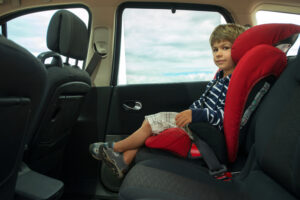How Can You Have Safety in the Face of Deceptive Marketing? The Critical Battle for Booster Seat Safety and Deceptive Marketing – A Legal Perspective

As a lawyer handling product liability cases, I’ve come across numerous instances that highlight the often dangerous shortcomings of child safety products. But nothing quite underscores the gravity of this issue like the comprehensive report by the U.S. House of Representatives Subcommittee on Economic and Consumer Policy on misleading marketing by Booster Seat Manufacturers. This report not only aligns with the disturbing trends I’ve observed in my practice but also sheds light on the alarmingly deceptive practices within the booster seat industry.
The Subcommittee’s investigation, a document dense with evidence and expert testimony, reveals a chilling reality: industry videos of booster seat side-impact tests clearly demonstrate that some children are placed in serious jeopardy when using these products. These videos are not some obscure technicality; they are visual evidence that children are at risk—a fact that has become a somber backdrop to my legal advocacy.
I represented a young girl who suffered paralysis after using a booster seat that was deceptively marketed as “side-impact tested” and as “meeting or exceeding all federal regulations.” Unbeknownst to the girl’s parents, the manufacturer had not designed the booster seat to provide side-impact protection especially given that there are no federal regulations concerning side-impact protections —facts concealed by the car seat manufacturer. The Subcommittee’s report revealed the perilous implications of such deceptive marketing. Evenflo, one of the implicated manufacturers, promoted its booster seats for children weighing as little as 30 pounds, directly contradicting the longstanding expert consensus that booster seats should not be used for children under 40 pounds. Despite facing multiple recalls in Canada for disregarding this safety guideline, Evenflo continued to market its products for 30-pound children in the U.S., investing significant resources to sustain this hazardous recommendation.
The Subcommittee’s findings are a searing indictment of the industry’s practices. They state: “Evenflo gives its booster seat a passing grade every time a child test dummy does not fully eject and the seat itself does not physically break apart.” This is a harrowing revelation—safety is reduced to the bare minimum, far removed from the realities of a crash. Graco and KidsEmbrace have similarly been called out for creating their own “weak testing conditions,” grading their booster seats on standards that are “nearly impossible to fail.”
The repercussions of these findings are not merely academic. As a legal professional who has seen the aftermath of these failures, I can attest to the profound impact on families. The NHTSA’s inaction, noted by the Subcommittee for not implementing a 40-pound minimum weight requirement nor establishing a side-impact testing standard, is not just a bureaucratic oversight—it’s a regulatory failure that has life-altering consequences.
In my practice, I’ve dedicated myself to challenging these dangerous practices and holding manufacturers accountable. The case I represented is a stark example of the vital role legal action plays in industry reform. By litigating, we do not only seek compensation for victims—we also push for transparency and safety improvements. If you have been affected by such negligence, the legal system provides a path to both personal restitution and the broader goal of industry-wide change.
The Subcommittee has made its stance clear, recommending that “NHTSA fulfill its duty to regulate booster seat safety” and encouraging the Federal Trade Commission and state Attorneys General to investigate and act upon these consumer protection violations. As a legal advocate and a father to 3 small children, I echo this call for action. It is high time that booster seat manufacturers are held to account not only in the courtroom but also in the court of public opinion.
We stand at a crossroads where each of us has the power to demand better standards and safer products. By staying informed, supporting legislative changes, and advocating for the enforcement of existing consumer protection laws, we can collectively ensure that the safety of our children is not a negotiable aspect of product design. The legal avenues available to us are not just for rectification but are tools for prevention, ensuring no other child suffers as a result of corporate negligence.
In conclusion, as we move forward, let us do so with the knowledge that our actions today will safeguard the child passengers of tomorrow. The fight for better safety standards in booster seats is far from over, but with continued vigilance and legal advocacy, we can make significant strides toward a future where deceptive marketing and inadequate testing are relics of the past.
Reference: “Booster Seat Manufacturers Give Parents Dangerous Advice: Misleading Claims, Meaningless Safety Testing, and Unsafe Recommendations to Parents About When They Can Transition Their Children from Car Seats to Booster Seats,” Staff Report, Subcommittee on Economic and Consumer Policy, Committee on Oversight and Reform, U.S. House of Representatives, December 10, 2020. oversight.house.gov
Share This


